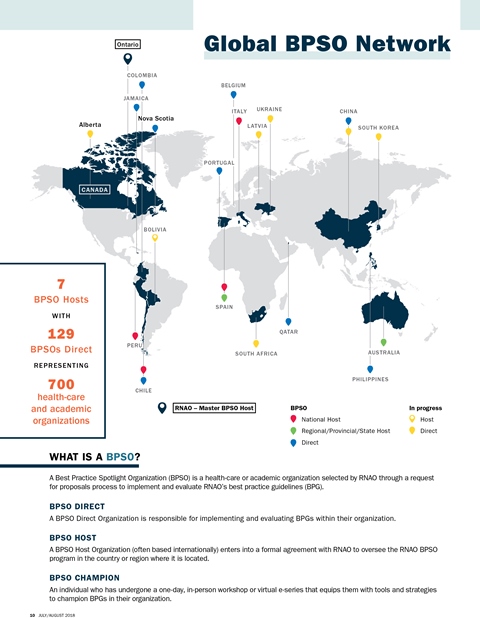By Lesley Young
According to RN Kathryn Hayward-Murray, senior vice president, patient care services, and chief nursing executive for Trillium Health Partners (THP), becoming a Best Practice Spotlight Organization (BPSO) while also going through a merger in 2012 united more than 10,000 employees and volunteers at three sites toward the same goal: improving patient care.
BPSOs are health-care and academic organizations selected by the Registered Nurses’ Association of Ontario (RNAO) to implement and evaluate RNAO’s best practice guidelines (BPG).
It was Hayward-Murray and Patti Cochrane (former CNE/VP at THP) who proposed the BPSO program to Michelle DiEmanuele, interim CEO at the time, who had a lot on her mind bringing together Credit Valley Hospital and Trillium Health Centre. “Of all the things I was thinking about, picking a team, stabilizing services and budgets, etc, becoming a BPSO was not top of the list. But as soon as it was in front of me, and we started talking, I knew it would be the perfect initiative to build a new organization and culture of quality.”
DiEmanuele says building a culture is key in any restructuring, and she quickly realized how the BPSO’s proven methodology, with a set of goals and a framework by which to get there, would get people excited.
The interprofessional team collaborated on the work to become a BPSO, and by the time the organization achieved designation in 2015, Trillium had implemented seven BPGs (they are currently working on three more). To note just a few of the many successes, after implementing the breastfeeding BPG, 75 per cent of new moms leaving the hospital exclusively breastfeed, compared to 54 per cent before the BPG was implemented, says Shelly Petruskavich, director, professional practice. “It was our groundwork through the BPG that was the start of the journey to THP attaining the Baby Friendly Initiative (BFI) in 2018.”
Thanks to RNAO’s healthy work environments nursing leadership BPG, Trillium has developed a unique program called Invitation to Leadership, which includes an interactive educational component, and also a formal mentorship component, says Hayward-Murray. The mentorship aspect was a win-win, she adds, as many of the mentors get a taste of point-of-care nursing from their mentees. So far, there have been 185 participants and a waiting list for every cohort.
Being a BPSO really allows for BPGs to be woven into the work of all professionals, points out Petruskavich. This is important in a large organization like Trillium, adds Hayward-Murray, noting there are many health-care initiatives that could be undertaken. There is also the bottom-line benefit to BPSO designation, DiEmanuele explains. “When I look at the BPSO (initiative), and the BPGs we’ve implemented, I know there is savings in duplication of work. More important is the improved patient experience to be had over time.”
Being a BPSO is truly a cultural predisposition at Trillium now, says DiEmanuele. “When we think about starting something, we always look at the BPGs. When suitable, we will pull in something (from a BPG). It’s a way of doing business and a way of practice for us.”
The Best Practice Spotlight Organization (BPSO) program is led by the Registered Nurses’ Association of Ontario (RNAO). This article originally appeared in a special 20th anniversary issue of Registered Nurse Journal, RNAO’s bi-monthly publication, alongside a variety of other articles celebrating two decades of best practice guidelines (BPG). RNAO is the professional association representing registered nurses, nurse practitioners, and nursing students in Ontario. Since 1925, RNAO has advocated for healthy public policy, promoted excellence in nursing practice, increased nurses’ contribution to shaping the health-care system, and influenced decisions that affect nurses and the public they serve. For more information about RNAO, visit RNAO.ca or follow us on Facebook and Twitter.


